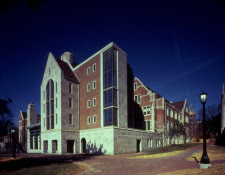I was a little concerned when I didn’t find Beverly Clearly’s name or picture at the Yakima Valley Library. I mean, if a Newbery Award winning author started out as a librarian in your library wouldn’t you want to show off? (even if she did get married and ditch you for California?) But then I learned that Cleary’s influence was too big to be hoarded by one library system - her legacy is shared between five Washington libraries (including the great Seattle Public Library) as part of the “The Cleary Community for 21st Century Youth”. The website is a meeting place for librarians interested in research and practice related to 21st century youth literacy. In addition to the sweetest Beverly Cleary picture ever, I leaned about the Beverly Cleary Sculpture Garden in Portland, Oregon (she has quite a hold on the entire Northwest). Cleary began her life in Oregon and moved to Portland in grade school. Klickitat Street, the famous setting of many of her books, was only a few blocks away from her home... that sounds like a great field trip.
 |
| photo from Multnomah County |
The Clearly Community link brought me to the Multnomah Public Library. Whenever I am reading about libraries in the Northwest this name pops up - and now I know why. According to the website the library was founded in 1864 and lays claim to the title of the oldest public library west of the Mississippi. Their collection includes 2 million books and provides services for a fifth of the state’s population. Their website is packed with resources, links, programs and opportunities for learning and fun. Their program for National DEAR (drop everything and read) Day caught my eye because of its famous spokesperson, Ramona Quimby! To celebrate Beverly Cleary’s birthday the library is showing the Beezus and Ramona movie at various branches, hosting toy and costume making workshops and offering a 90 minute walking tour of Klickitat Street and Beverly Cleary’s home.
The library website provides a comprehensive parent portal for Portland. Under a link entitled “Around Portland” you can access information about parks, sports, kids classes, zoos, entertainment, day trips and museums, without being bombarded by advertising. When I found my way to the Cleary Sculpture Garden page, I discovered an itemized PDF map of the Cleary’s neighborhood with descriptions of each character and the book they were featured in. The page also provides close ups of the sculptures and pictures of Cleary and her husband in the garden. Can you imagine how much fun it would be to teach elementary school in Portland? After reading the “whole shelf” of books and conducting an author study (powerpoint, reports, costumes, etc.) the class could take a walking tour to see and sketch the houses then finish the day with lunch in the sculpture garden. Even my most reluctant readers would be jazzed about a day like that.
In addition to their mission statement, The Multnomah Public Library has a document that highlights seven service priorities including a focus on early literacy, school success and customer service but the Cleary pages speak to their last priority: facilitating civic engagement. They didn’t have to tell me that they wanted to provide “resources that support, create opportunities for, and inspire participation in our community” it was written all over their site.












